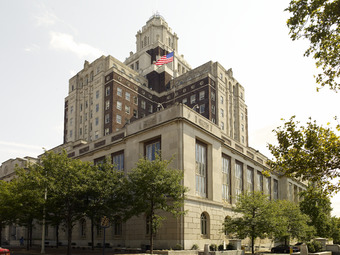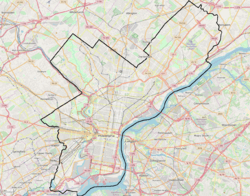United States Custom House (Philadelphia) facts for kids
|
United States Custom House
|
|

2007 oblique view of the building
|
|
| Location | 200 Chestnut St. Philadelphia, Pennsylvania |
|---|---|
| Built | 1932-34 |
| Architect | Ritter & Shay |
| Architectural style | Art Deco |
| NRHP reference No. | 11000310 |
Quick facts for kids Significant dates |
|
| Added to NRHP | May 25, 2011 |
The United States Custom House is an important historic building in Philadelphia, Pennsylvania. It was built between 1932 and 1934 in the Art Deco style by architects Ritter & Shay. This large building takes up an entire city block in the oldest part of Philadelphia, near Second, Chestnut, and Sansom Streets.
Its south and west sides are right next to Independence National Historical Park. Standing 17 stories tall and about 287 feet high, this huge building is much taller than other historic buildings nearby. Today, the building is home to several U.S. government offices, including the U.S. FDA, Department of State, Department of Homeland Security, National Park Service, and U.S. Customs and Border Protection.
The building was updated in the early 1990s and again from 2010 to 2013. It was officially added to the National Register of Historic Places on May 25, 2011, recognizing its importance.
Contents
Building History: A Depression-Era Project
The U.S. Custom House in Philadelphia was one of many big building projects started by the U.S. government during the Great Depression. Construction began in December 1932 as part of the Works Progress Administration (WPA). The WPA was a program that helped people find jobs during tough economic times. The Custom House opened on November 10, 1934, and cost over $3.5 million to build.
This building is known for its rich materials, great design, and beautiful artwork by a local artist. It stands as a symbol of Philadelphia's importance as a major port city.
Why a New Custom House?
As Philadelphia grew into a busy industrial center in the early 1900s, more and more ships came and went from its port. The U.S. Customs Service, which handles goods coming into the country, needed more space. Since 1845, they had been in the Second Bank of the United States building. That building was designed by William Strickland and finished in 1824. But it was no longer big enough.
Helping the Economy
The new U.S. Custom House shows us what life was like in the early 1930s. It highlights how the WPA helped fight unemployment by creating large building projects. These projects hired local craftspeople, suppliers, and manufacturers, giving workers fair wages.
After the stock market crash in 1929, Congress passed a law to provide money for the U.S. Custom House in Philadelphia. Building it helped the local economy by directly hiring over 4,000 workers for two years. This project was also the first step in a bigger plan to improve the city, which later included creating Independence National Historical Park and making Society Hill a better place.
Architecture: Blending Old and New Styles
The U.S. Custom House was the last major project by Ritter & Shay, a famous architectural firm in Philadelphia. The building's design respected the historic 18th-century neighborhood around it by using classic details on its lower part. However, it also showed off its own time with a bold, modern Art Deco tower. This tower has smooth surfaces and gets narrower towards the top.
Building Design and Materials
The U.S. Custom House covers an entire city block in Philadelphia's Historic District. It rises 17 stories from its base to its top. The lower three stories are covered in limestone with decorative aluminum details and steel windows. This classical base fits well with the older Georgian and Federal style buildings nearby. Above the main entrance, you can see metal panels with pictures of American industry, trade, and business.
The tower part of the building is set back from the base. It is made of red brick with limestone trim and wooden windows. The building reaches almost 300 feet high, ending in an eight-sided top section called a lantern. This lantern is made of white terra cotta with decorative grilles and limestone eagles. The lantern used to have a powerful light that burned logs and oil to create a bright flame at night and dark smoke during the day.
Inside the Custom House: Art and Design
The inside of the Custom House is special because of the teamwork between artist George Harding, architect Howell Lewis Shay, and Philadelphia Museum of Art director Fiske Kimball. Harding created 31 amazing murals (large paintings) in the entrance area, elevator lobby, and rotunda. These artworks feature nautical scenes and images of trade, like ships, planes, seashells, seahorses, and even Neptune. These designs perfectly match the building's purpose next to one of the world's largest freshwater ports.
The first floor has a clear layout that leads to a three-story rotunda (a round room) with a fancy plaster ceiling. A domed ceiling, supported by eight marble columns, covers the rotunda. Each part of the ceiling looks like a large gold shell. The decorative band around the room shows eight panels of the winds from Greek mythology. On either side of the main hallway, there are beautiful circular stairs that go up to offices on the second and third floors.
Even though it seems to be in the middle, the rotunda is actually at the front of the building. It cleverly hides the loading docks, which take up almost half of the first floor.
In the early 1990s, the U.S. General Services Administration worked to restore the U.S. Custom House. This three-year project included fixing the original surfaces, updating the heating and lighting, and making sure the building was accessible for people with disabilities. Today, the building is fully used, and its energy costs have been cut by 60 percent.
Important Dates
- 1789: The U.S. Customs Service is created on July 31.
- 1845: The U.S. Customs Service moves into the Second Bank of the United States.
- 1932: Money for the building is reduced, so limestone is used instead of marble.
- 1934: The U.S. Customs Service moves into its current building at Second and Chestnut Streets.
- 1984: The building is added to the Philadelphia Register of Historic Places on December 31.
- 1991: The building is listed on the National Register of Historic Places as part of the Independence National Historical Park Historic District.
- 1991-1993: The U.S. General Services Administration completes a major restoration and update of the building.
- 2010-2012: The building goes through another major renovation.
- 2011: The building is listed separately on the National Register of Historic Places.
Images for kids








